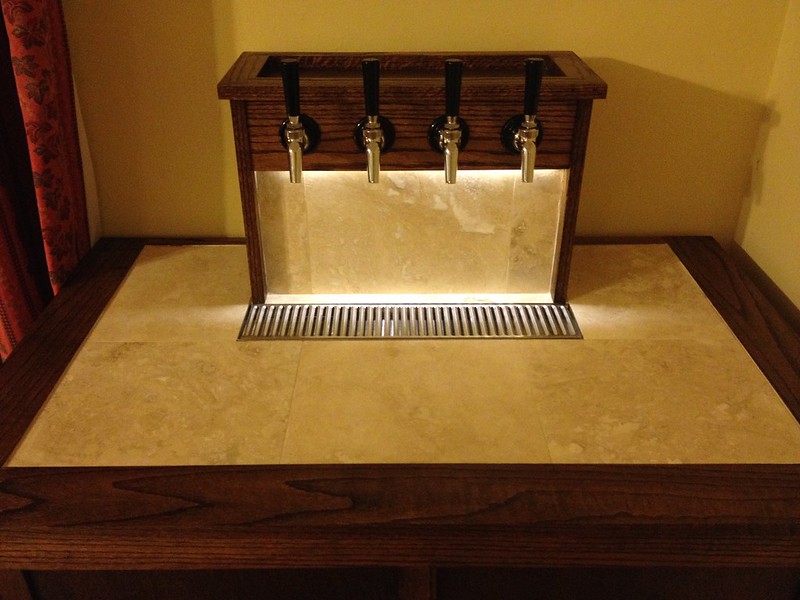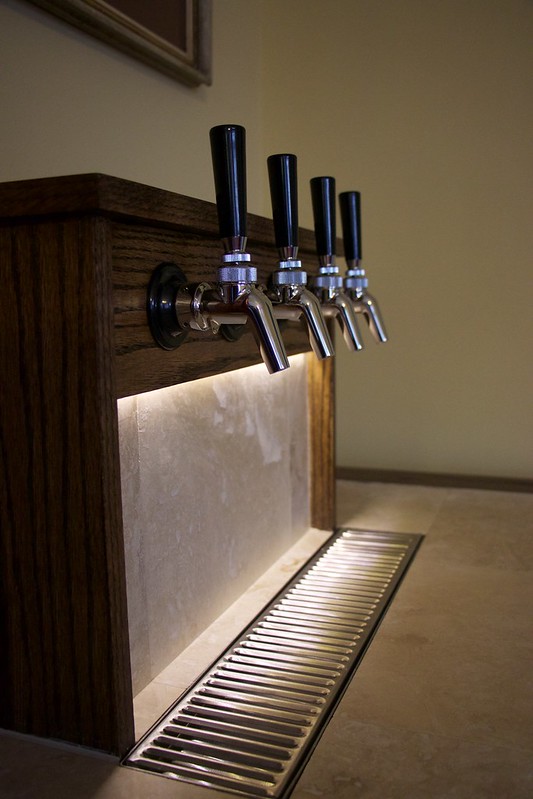The coffin structure is two pieces of oak for the sides joined by 4 pieces of plywood. A further piece of plywood is added to the front to hold the oak board that the taps go through. The two plywood pieces at the back will support the rear cover; the plywood at the front bottom supports the front ply that will be tiled. Some people have made these by creating a plywood box and cladding it with the finish wood. No real reason to add to the thickness of the side of the coffin like that. I like the little angle that the Jester keezer has from a few inches up rather than entirely straight coffin sides - I think it makes it just a little less heavy looking.
Here's the box built out with plywood at the front and top and trimmed with oak at the top and the oak tap board at the front. There's a little gap under the plywood at the front to allow the tile to recess behind it. That's pure laziness so I didn't have to make an additional cut to the stone.
The coffin does need cooling. Since the air is coldest at the bottom of the freezer it make sense to bring the air up from there. I do that by recessing a plastic pipe fitting into the lid, and attaching a piece of flexible hosing to it that reaches the bottom of the freezer. I just looked around Home Depot for whatever they had - I think it was in the swimming pool section.
Some people have a box with a fan at the bottom of the pipe. I decided to put my fan in the coffin and pull the air up it. I built a little fitting for the fan to hold it snug in place over the top of the pipe. It's a 12v computer fan rated for reasonably low noise.
Here are the electrical / electronic connections. Some notes here since there are quite a few questions in the forums and I didn't find a whole pile of answers (they're probably there - I just didn't come across them).
1) The temperature controller is an STC1000. These are about $17 from Amazon. If you get a version of this that only cools (which is all you need) you can get one for about $12. That's a whole lot cheaper than a Johnson temperature controller.
2) The power comes into a standard wall mount box (a couple of dollars from Home Depot) using a power tools replacement power cord rated for 15A (I think about $12). The left hand side is a duplex outlet (
currently 68 cents at Home Depot) which is wired straight to the power cord. The right side is switched by the STC1000. I originally thought I would remove the tab between the two outlets of a single duplex unit - but couldn't figure it out, and there was enough space for a two gang box so I just went that way. The face plates etc... are also very inexpensive. You have to shop a little careful - the basic versions of all these electric bits are much cheaper than some of the fancier ones.
The switching works like this - the neutrals of the left and right outlets are connected together - only the live is switched. [All grounds are also connected together inside the box]. The live leaves the left outlet and goes to the switched cool circuit on the STC1000. It is then brought back from there to the live connector of the right outlet.
The STC1000 also needs power - so the live from the outlet is also sent to the live power in of the STC (it's split with the red wire connector) and the neutral connection is joined from the STC unit to an available neutral connection on the outlets. The wire is 12 gauge hook up wire - but short lengths from inside any 15A rated cable would be fine.
This is very easy but it is electrics - so if in doubt look up wiring an outlet and a switch on Google.
3) This allows the freezer just to plug into the switched side with no other adjustment to the freezer whatsoever.
4) The left hand side has the 12v transformer plugged into it. This goes to a dimmer switch ($3 or so from Amazon) which I removed from its original housing in order to fit through the rear panel. I soldered the transformer wires to the inputs of the dimmer switch and a little hook up wire from the same place to go onto a switch for the fan (you just need the red and black wires on the fan). I reutilised the original connectors at the far side of the dimmer switch (on the right hand side of the photo) to join to the wire going to the led lights so that the electronics can be removed easily from the coffin.

I used some of the insulation that I bought for the lid to pad out the inside of the coffin. As you can see there are plenty of gaps - but I figured some insulation would be better than none and didn't get too obsessive about it... I used little pieces of plywood to hold the nuts on the back of the beer shanks - I didn't fancy getting a spanner right up the tap board. Taps and connectors all came from BeverageFactory.com - which I found fairly reasonable; Kegs came from Adventures in Homebrewing which were much cheaper than anyone else for new Corny kegs with rubber tops and bottoms. I had been planning on used cornies - but these were sufficiently close to the used prices to be prepared to splash out. Generally most places are much of a muchness on pricing and I'm sure they change all the time in any event.
The rear cover for the coffin is plywood lined with some insulation - it's missing here so that you can see inside.
The taps are Perlick 630SS and the shanks are all stainless too. This seems a fairly standard choice and people seem to reckon that stainless is worth the little extra. The led lighting was
$8 for a 5 metre strip from Amazon - which is great; I want to put it under my kitchen cabinets now! (I've got >4 metres left!).
The coffin lighting looks so good on the Jester keezer picture and just as good in real life - I'd definitely recommend going for this as part of the design of the coffin.














































































![Craft A Brew - Safale BE-256 Yeast - Fermentis - Belgian Ale Dry Yeast - For Belgian & Strong Ales - Ingredients for Home Brewing - Beer Making Supplies - [3 Pack]](https://m.media-amazon.com/images/I/51bcKEwQmWL._SL500_.jpg)






